Carl Zeiss Vergr.=8 (Vergr.=8x)
| Das Carl Zeiss Monokular mit den Werten 8x20 hat die Seriennummer "230". Das Okular mit Augenmuschel ist aus einem Bakelitstück mit einer Dioptrienskala von 0-15, lediglich in einer Richtung markiert. Das Okular lässt sich anhand einer spiralförmigen Nut, in die ein am drehbaren Messingokular befestigtes Gegenstück greift, um ca. 340° drehen (s. Bild des demontierten Okulars). Das Bakelitstück ist wiederum auf das bewegliche Okulrstück geschraubt. Der feste Okulartubus hat eine Refernzlinie; im Tubus zum Gehäuse zeigend hin ist eine kleine Gesichtsfeldblende eingeschraubt. Der obere Deckel ist mit der geschwungenen Zeiss-Handschrift beschriftet "Carl Zeiss Jena Vergr. = 8". Beide Messingdeckel sind dreifach verschraubt und schwarz lackiert. Der untere Deckel ist außerdem noch mit der Adresse des Britischen Vertriebspartners "AGENTS Ross * Ltd. 111. New Bond St. London. W." gekennzeichnet. Das Aluminiumgehäuse ist lederummantelt. An ihm ist ein über die ganze Länge gehender 5cm langer Metallstreifen mit einer Trageöse zweifach angeschraubt. Alle Merkmale sprechen für ein Herstellungsdatum von 1897. |
The Carl Zeiss monocular wit 8x20 specifications has serial number 230. The ocular with its eyecup is one single Bakelite piece. Its dioptre scale runs in one direction only, starting with zero and ending with a 15 mark. disassembling the eyepiece you can see in the picture that a groove spirals around the brass tube. A tiny brass counterpart is fixed with two screws to the turning ocular part, on which again the Bakelite piece is screwed on. so the ocualr can be truned about 340°. The fixed ocular part has a dioptre reference line. At its opening in direction to the housing a lens diaphragm is inserted. The top cover is marked "Carl Zeiss Jena Vergr.= 8" with the cursive Zeiss script. Both brass cover plates are painte black and fixed with 3 screws. Furthermore the bottom cover is marked "AGENTS Ross * Ltd. 111. New Bond St. London. W.", the British distributor. The aluminium housing is coverd with leather. It has a 5cm metal slip (as lonmg as the housing) with a strap lug attached by two screws. All these features hint at a production date of 1897. |
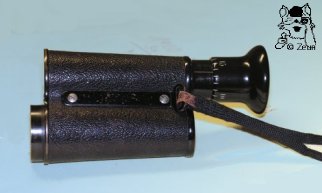

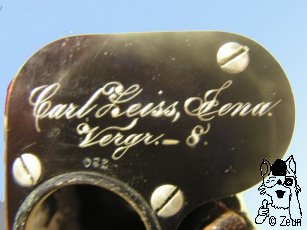
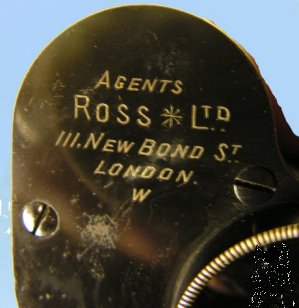
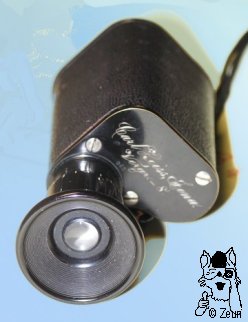
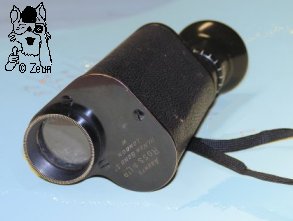
| Das Monokular wiegt 148g bei einer Länge von 99mm bis 106mm (je nach Okulareinstellung) und einer Breite von 39x39mm oben und 45x45mm unten am Gehäuse. Die Objektivlinsenfassung ist 25mm und das Okular 18,2mm beim feststehenden und 21mm im Durchmesser am drehbaren Teil; der Augenmuschelrand misst 32mm. | The monocular weighs 148g, being 99mm to 106mm in length – depending on ocular adjustment – and the housing being 39x39 at its top and 45x45mm at its bottom. The objective lens frame has a 25mm diameter, the ocular tube one of 18.2mm and 21mm at that turning part. The outer eyecup measures 32mm. |
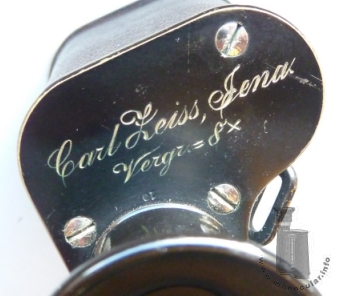
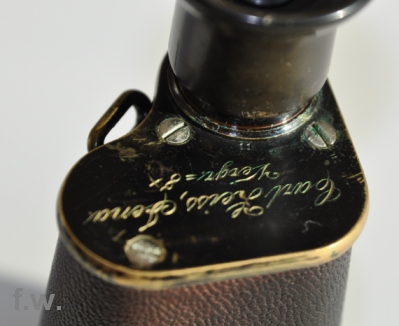
| Zwei mir bekannten Exemplare haben die Seriennummern 10 und 11 und dürften aus einer sehr frühen Kleinserie von Ende 1896, Anfang 1897 sein. Sie haben noch ein 3/3 Okular ohne Dioptrienskala und mit glatter Oberfläche der Vaulkanitaugenmuschel. Die "Carl Zeiss Jena" Gravur variiert von den oben beschriebenen Exemplaren, unterscheidet sich aber vor allem durch die Bezeichnung "Vergr.=8x", also mit "x". Andere Merkmale sind identisch zu den oben beschriebenen Modellen. | Two models I know come with the serial number 10 and 11. Assumingly, they are models of a early batch dating from about the end of 1896 anor beginning of 1897. They still have a 3/3 eyecup without any dioptre scale, but with a smooth surface of the vulcanite eyecup. THe "Carl Zeiss Jena" engraving varies from those described above, and especially differs in its designation "Vergr.=8x", i.e. with an "x". Other characteristics are the same like thsoe described above. |
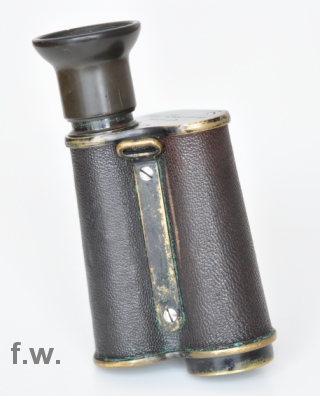
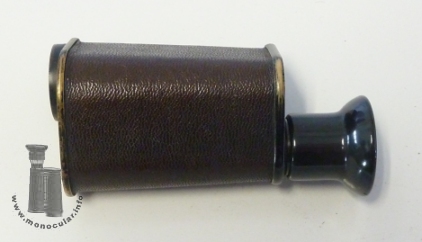
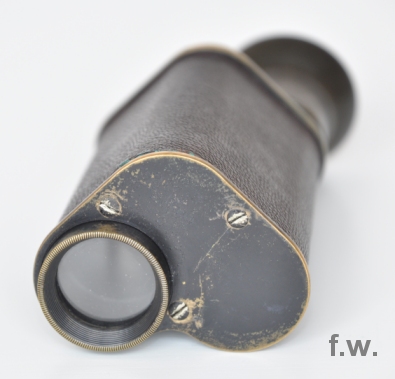

Fotos: Zeun; F. Weissörtel

